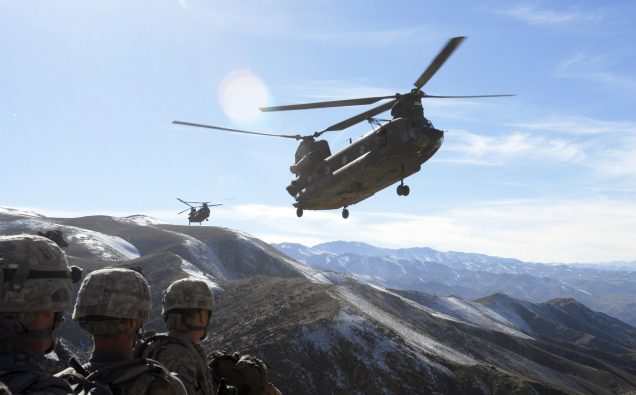
A 2008 image shows US soldiers watching as two Chinook helicopters fly in to take them back to Bagram Air Field, Photo Credit:Spc. Mary L. Gonzalez, via Wikimedia
As the Trump Administration seeks answers to Afghanistan quagmire – Kabul’s unending internal political fighting, a dangerous ISIS mix and inability of Afghan forces to contain the Taliban insurgency – a major American newspaper has warned Washington against beefing up deployment.
The New York Times said Afghanistan is now President Donald Trump’s war but reminded the U.S. decision makers that the past reinforcements had ” failed or fell well short of their aims” toward Afghan stability.
“Before the White House responds to the Pentagon’s latest request for a troop surge in Afghanistan to counter insurgent forces that now control substantial parts of the country, it would serve administration officials well to examine the long history of deluded thinking about what could be accomplished if the United States committed more troops to the effort,” the Times said .
In an editorial, ‘Afghanistan Is Now Trump’s War,’ the newspaper notes that Afghanistan – which was a haven for al-Qaeda perpetrators of 9/11 attacks – remains in the grip of a “resolute insurgency and a kleptocratic, dysfunctional governing elite,” more than 15 years after U.S. invaded the country.
The situation in Afghanistan has been festering on many fronts. President Ashraf Ghani and Chief Executive Officer Abdullah Abdullah are often at odds with each other on political and governance issues while the country continues to slide back into chaos that could fester into lawlessness – a fear that makes Western countries to keep investing in the country despite few signs of progress.
In recent months, Afghanistan has particularly lost control of territory once under Kabul’s rule to Taliban factions. The Times said the Afghan forces are getting killed and injured at a rate American commanders call unsustainable.
Just a few days ago, IS militants attacked a military hospital in Kabul killing several people in a daring challenged to the rulers.
Last month, Gen. John Nicholson, the current top commander in Afghanistan, told lawmkers during a testimony that America’s longest war is in a “stalemate” and lamented what he called a “shortfall of a few thousand” troops.
Currently, an international coalition is maintaining 13,000 troops in the landlocked country, including about 8,400 Americans. This week Centcom Chief Gen. Joseph Votel said military leaders are drawing up a new strategy that would require more American troops.
But the Times said, “White House officials and members of Congress should consider this request with skepticism. The challenges that have stymied American generals in Afghanistan for years — including havens for insurgents in Pakistan, endemic corruption and poor leadership in the Afghan military — remain unsolved. In the absence of a dramatically different approach to those problems, any new reinforcements can only be expected to shore up the fledgling Afghan government for a year or two.”
Against this background, the Times says any decision warrants serious deliberations.
“Sending troops into harm’s way is among the most difficult responsibilities of a commander in chief. Yet there is little evidence that President Trump and his national security team have given the matter substantial consideration since his inauguration. Mr. Trump in 2013 favored a full withdrawal from Afghanistan, calling the war a waste of money. Last year, he said he would stay in Afghanistan, although, he said, ‘I hate doing it so much’.
“Before he agrees to increased troop numbers, Mr. Trump would be wise to order a full assessment of the war to consider whether sending in more Americans can reasonably be expected to succeed in weakening an insurgency that has sprung back after earlier increases of American force.
“Unless the Pentagon delivers a strategy that is significantly different from previous ones, Mr. Trump would be sending more men and women into a deadly war zone while, at best, only temporarily delaying Afghanistan’s descent into further chaos and violence,” the paper says on a cautionary note.















